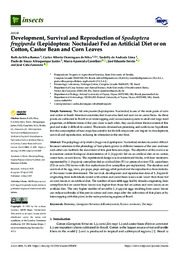Development, survival and reproduction of Spodoptera frugiperda (Lepidoptera: Noctuidae) fed an artificial diet or on cotton, castor bean and corn leaves.
Development, survival and reproduction of Spodoptera frugiperda (Lepidoptera: Noctuidae) fed an artificial diet or on cotton, castor bean and corn leaves.
Autoria: RAMOS, R. da S.; SILVA, C. A. D. da; LIMA, T. de A.; ALBUQUERQUE JÚNIOR, P. de S.; CASTELLANI, M. A.; SERRÃO, J. E.; ZANUNCIO, J. C.
Resumo: The polyphagy of Spodoptera frugiperda (Lepidoptera: Noctuidae) renders its control difficult because variations in the phenology of host plants grown in different seasons of the year and near each other can facilitate the movement of this pest between crops. The objective of this work was to examine certain biological characteristics of S. frugiperda fed on an artificial diet or on cotton, castor bean, or corn leaves. The experimental design was in randomized blocks, with four treatments represented by S. frugiperda caterpillars fed an artificial diet (T1) or pieces of cotton (T2), castor bean (T3) or corn (T4) leaves with five replications (five caterpillars per replication). The duration and survival of the egg, larva, pre-pupa, pupa and egg-adult period and the reproductive characteristics of this insect were determined. The survival, development and reproduction data of S. frugiperda originating from individuals reared with cotton and castor bean leaves were lower than those fed on corn leaves or an artificial diet. The number of nonviable eggs laid by females originating from caterpillars fed on castor bean leaves was higher than those fed on cotton and corn leaves or an artificial diet. The very higher number of unviable S. frugiperda eggs resulting from castor leaves can reduce outbreaks of this pest in cotton and corn crops after the cultivation of that plant, or by intercropping with this plant, in the main producing regions of Brazil.
Ano de publicação: 2022
Tipo de publicação: Artigo de periódico
Unidade: Embrapa Algodão
Palavras-chave: Algodão, Bionomia, Castor beans, Cotton, Fall armyworm, Gossypium Hirsutum, Lagarta, Mamona, Milho, Ricinus Communis, Zea Mays, Zea mays subsp. mays
Observações
1 - Por padrão são exibidas publicações dos últimos 20 anos. Para encontrar publicações mais antigas, configure o filtro ano de publicação, colocando o ano a partir do qual você deseja encontrar publicações. O filtro está na coluna da esquerda na busca acima.
2 - Para ler algumas publicações da Embrapa (apenas as que estão em formato ePub), é necessário ter, no celular ou computador, um desses softwares gratuitos. Sistemas Android: Google Play Livros; IOS: iBooks; Windows e Linux: software Calibre.
Acesse outras publicações
Acesse a Base de Dados da Pesquisa Agropecuária (BDPA) para consultar o acervo completo das bibliotecas da Embrapa.

